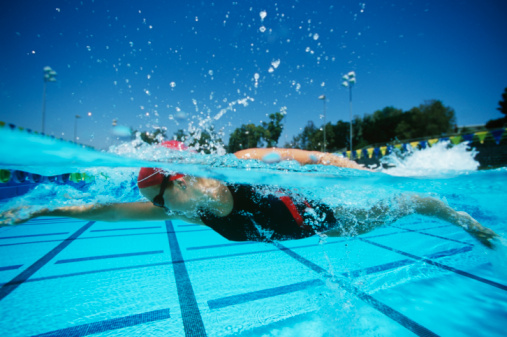
In general, swimming is an excellent activity that is easy on the back and spine. Unlike running and other forms of aerobic exercise, there is practically no impact on the spinal structures while swimming. The water supports the body, relieving stress on all joints in the body. There are, however, some instances in which swimming can cause neck or back pain:
- The lower back can remain hyper-extended during front strokes, the crawl or breaststroke and butterfly.
- The neck may be jerked backward repetitively during front strokes while taking breaths when swimming.
To prevent any neck or back pain during a swim, keep these tips in mind:
- Use proper form for front strokes, such as the crawl or breaststroke, while swimming: keep your body level in the water (hold lower abdominal muscles up and in) and keep the head straight rather than lifted.
- If preferable, swim with side or back strokes instead of front strokes
- Roll the body to the side and keep the chin in when taking breaths during the crawl, rather than jerking the head backward, to reduce the amount of movement in the neck while swimming
- Wear goggles to reduce improper head movements when trying to keep water out of the eyes
- Use flotation devices (noodles, boards, life preservers, wet vest) to maintain proper form when swimming.
Additionally, diving presents greater risk for severe injury to the spine. In fact, diving into shallow water can lead to a broken neck or severe spinal cord injury. The National Spinal Cord Injury Statistical Center reports that 800 Americans are permanently paralyzed annually as a result of diving accidents. To avoid injury, keep in mind the following tips when you dive:
- Do not dive in shallow water.
- Don’t dive into murky water. You should be able to see the bottom of a pool at the deepest point.
- Do check the depth of the full diving area to make sure it is deep enough.
- Dive only off the end of a diving board. Do not run on the board, try to dive far out, or bounce more than once. Swim away from the board immediately after the dive, to allow room for the next diver. Make sure there is only one person on the board at a time.
Should you or someone you’re with be hurt while swimming or diving, immediately assess the injury. If it is life threating, immediately call 911 or visit the nearest emergency department. If the injury is non-life threatening, see your doctor as soon as possible or visit SOS PLUS After Hours Care, a walk-in orthopedic medical clinic that treats patients of all ages with acute orthopedic conditions requiring immediate attention. SOS Plus has two locations, at 5719 Widewaters Parkway in Dewitt and 5000 West Seneca Turnpike in Onondaga Hill. Hours for both locations are weekdays 5 pm – 8:30 pm, and weekends 10 am – 2 pm.